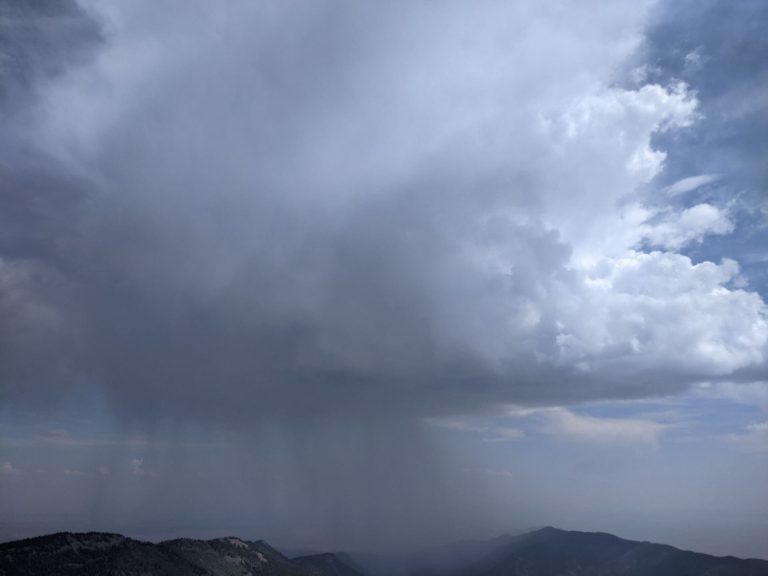go through: PhD. Hripsim Mkrchiyan
Thunderstorm surface intensification is an atmospheric phenomenon that describes a significant increase in ground radiation during thunderstorm activity. This effect is primarily attributed to the acceleration of charged particles by strong electric fields within thunderclouds, which can lead to an increase in detectable gamma radiation at the Earth's surface.
In the 1920s, Wilson theorized that the dipole structure of thunderclouds could accelerate electrons toward the ground. However, the theory did not gain immediate acceptance. Some 60 years later, it was finally verified that the electrical structure of thunderclouds does have the ability to accelerate particles downward or upward.
Over the past decade, most thunderstorm ground enhancements (TGEs) have been detected at the Cosmic Ray Department of the Alihanyan National Scientific Laboratory in Mount Aragats, Armenia. Equipment installed at the station includes particle detectors with different energy thresholds, electric field mills, a lightning detection network and a weather station.

Cosmic Ray Department Aragats Research Station, A. Alikhanyan State Scientific Laboratory on Aragats Mountain (3200 m above sea level) (Copyright by Andranik Keshishyan)

TGE registrations are more frequent in May as thunderstorm activity in Armenia is very high during this period. TGE can include high-energy electrons, gamma rays, and neutrons and last from minutes to hours, depending on the energy levels of the particles involved. The flux of low-energy particles (less than 3 MeV) can last for more than two hours, and the flux of high-energy particles (energy up to 40 MeV) can last from 1 to 10 minutes (Chilingarian, 2018). Thunderclouds can thus act as natural accelerators, producing the enhancements in particle flux recorded on the ground during thunderstorms.
The electric field enhanced by the particles detected on the surface can have either positive or negative polarity. These enhancements are attributed to microphysical processes involving clouds and precipitation particles in these storms. However, until recently, the reasons behind polarity assignment remained unclear.

Illustration of the complete tripole structure with deep (and cooler) convection with “negative” thunderstorm surface enhancement (TGE) (right), and bottom heavy convection with shallow (and warmer) convection with “positive” TGE (left) Three-pole structure. Source Williams E et al. 2022 (https://agupubs.onlinelibrary.wiley.com/doi/10.1029/2021JD035957)
In a recent study by Williams et al. (2022) combined high-energy particle, electric field, and radar observations to reveal new insights into these high-energy phenomena. In their study, they used shotgun, highly resolved S-band radar observations (graupel is a form of precipitation produced through a process called “dawning”) to highlight storms associated with “positive” and “negative” TGE obvious differences in structure. Their results show that shallow stages of convection are associated with “positive” TGE, while deep stages of convection are associated with “negative” TGE. These results are consistent with the temperature-dependent electric tripole structure of thunderclouds.
The study of surface intensification of thunderstorms is important for improving our fundamental understanding of atmospheric physics. It could also have practical impacts in areas such as aviation safety, radio communications and environmental monitoring. Future research is expected to delve more deeply into the mechanisms behind TGEs, explore how different atmospheric conditions and storm structures affect surface radiation enhancement, measure the vertical profile of the electric field in TGEs, and answer the question of whether non-existent storms exist. Ongoing research into thunderstorm phenomena and related atmospheric processes continues to reveal the complex interactions within thunderclouds and their effects on the ground. As technology and methods advance, we expect more detailed insights will be available that will further demystify thunderstorm surface enhancement.

In summary, TGE represents a significant interaction between thunderstorm activity and terrestrial radiation, highlighting the complex dynamics within thunderclouds and their ability to influence ambient radiation levels. Further research in this area continues to reveal the mechanisms behind TGE and its implications for understanding atmospheric physics and environmental monitoring.
refer to:
- Williams E, Maiyan B, Karapetyan G, Mkrtchyan H. Conditions for thunderstorm ground enhancement of medium and high energy electrons and gamma raysJournal of Geophysical Research: Atmospheres , 2023
- Williams, E., Mkrtchyan, H., Mailyan, B., Karapetyan, G. and Hovakimyan, S. Radar diagnostics of thundercloud electron accelerators. Journal of Geophysical Research: Atmospheres, 2022
- Chilingarian A., Hovsepyan G., Karapetyan T., Karapetyan G., Kozliner L., Mkrtchyan H., et al. Thunderstorm ground enhancement structures. physics. Rev. D 101, 122004, June 22, 2020
- Chilingarian A., Mkrtchyan H. et al. Catalog of thunderstorm ground enhancement (TGE) events observed in Aragat for 2017. Scientific Reports, vol. 9. Article number: 6253, 2019
- Chiringaan, A. (2018). Persistent low-energy thunderstorm surface enhancement and possible Rn-222 daughter isotope contamination. Physical ReviewD.
